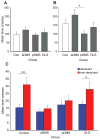Posterior dorsomedial striatum is critical for both selective instrumental and Pavlovian reward learning
- PMID: 20345912
- PMCID: PMC2914557
- DOI: 10.1111/j.1460-9568.2010.07153.x
Posterior dorsomedial striatum is critical for both selective instrumental and Pavlovian reward learning
Abstract
The dorsal striatum (DS) has been implicated in instrumental learning but its role in the acquisition of stimulus-driven behaviour is not clear. To explore the contribution of the DS to both response-outcome (R-O) and stimulus-outcome (S-O) associative learning, we pharmacologically inactivated subregions (dorsolateral, anterior dorsomedial and posterior dorsomedial) of the DS during acquisition sessions in which subjects acquired two unique, novel R-O pairs or two unique, novel S-O pairs. To test whether specific R-O or S-O associations were learned under inactivation, rats were tested following selective-satiety devaluation of one outcome under drug-free conditions. In the instrumental task, control rats and rats with dorsolateral striatum (DLS) inactivation during learning responded less on the lever that had earned the devalued outcome than on the alternative lever at test, indicating that the DLS is not critical for the formation of R-O associations. In contrast, rats with inactivation of the medial DS (DMS) (either anterior or posterior) during learning responded indiscriminately, suggesting failure to acquire the novel R-O associations. In the Pavlovian task, both controls and rats with anterior DMS inactivation during learning responded less in the presence of the stimulus predicting the devalued outcome, whereas rats with DLS or posterior DMS inactivation during learning responded equally to the stimuli, indicating that they had not acquired the novel S-O associations. These data confirm that the DLS and anterior region DMS mediate different aspects of reward-related learning, and suggest that the posterior DMS may mediate a function common to both forms of learning (R-O and S-O). Finally, we demonstrate that both S-O and R-O associations are required for selective Pavlovian-instrumental transfer.
Figures




Similar articles
-
The role of the amygdala-striatal pathway in the acquisition and performance of goal-directed instrumental actions.J Neurosci. 2013 Nov 6;33(45):17682-90. doi: 10.1523/JNEUROSCI.3271-13.2013. J Neurosci. 2013. PMID: 24198361 Free PMC article.
-
Inactivation of the lateral but not medial dorsal striatum eliminates the excitatory impact of Pavlovian stimuli on instrumental responding.J Neurosci. 2007 Dec 19;27(51):13977-81. doi: 10.1523/JNEUROSCI.4097-07.2007. J Neurosci. 2007. PMID: 18094235 Free PMC article.
-
Pharmacological manipulations of the dorsomedial and dorsolateral striatum during fear extinction reveal opposing roles in fear renewal.Neurobiol Learn Mem. 2024 Jul;212:107937. doi: 10.1016/j.nlm.2024.107937. Epub 2024 May 11. Neurobiol Learn Mem. 2024. PMID: 38735637 Free PMC article.
-
Still at the choice-point: action selection and initiation in instrumental conditioning.Ann N Y Acad Sci. 2007 May;1104:147-71. doi: 10.1196/annals.1390.006. Epub 2007 Mar 14. Ann N Y Acad Sci. 2007. PMID: 17360797 Review.
-
Dorsal and ventral streams: the distinct role of striatal subregions in the acquisition and performance of goal-directed actions.Neurobiol Learn Mem. 2014 Feb;108:104-18. doi: 10.1016/j.nlm.2013.11.003. Epub 2013 Nov 11. Neurobiol Learn Mem. 2014. PMID: 24231424 Free PMC article. Review.
Cited by
-
Distinct recruitment of dorsomedial and dorsolateral striatum erodes with extended training.Elife. 2019 Oct 17;8:e49536. doi: 10.7554/eLife.49536. Elife. 2019. PMID: 31621583 Free PMC article.
-
Habits Are Negatively Regulated by Histone Deacetylase 3 in the Dorsal Striatum.Biol Psychiatry. 2018 Sep 1;84(5):383-392. doi: 10.1016/j.biopsych.2018.01.025. Epub 2018 Feb 8. Biol Psychiatry. 2018. PMID: 29571524 Free PMC article.
-
Distributed processing for value-based choice by prelimbic circuits targeting anterior-posterior dorsal striatal subregions in male mice.Nat Commun. 2023 Apr 6;14(1):1920. doi: 10.1038/s41467-023-36795-4. Nat Commun. 2023. PMID: 37024449 Free PMC article.
-
Dorsomedial Striatum (DMS) CB1R Signaling Promotes Pavlovian Devaluation Sensitivity in Male Long Evans Rats and Reduces DMS Inhibitory Synaptic Transmission in Both Sexes.eNeuro. 2025 Jan 29;12(1):ENEURO.0341-24.2024. doi: 10.1523/ENEURO.0341-24.2024. Print 2025 Jan. eNeuro. 2025. PMID: 39746803 Free PMC article.
-
Effects of repeated cocaine exposure on habit learning and reversal by N-acetylcysteine.Neuropsychopharmacology. 2014 Jul;39(8):1893-901. doi: 10.1038/npp.2014.37. Epub 2014 Feb 17. Neuropsychopharmacology. 2014. PMID: 24531561 Free PMC article.
References
-
- Adams CD, Dickinson A. Instrumental responding following reinforcer devaluation. Q J Exp Psychol. 1981;33B:109–121.
-
- Alexander GE, DeLong MR, Strick PL. Parallel organization of functionally segregated circuits linking basal ganglia and cortex. Annu Rev Neurosci. 1986;9:357–381. - PubMed
-
- Alloway KD, Lou L, Nwabueze-Ogbo F, Chakrabarti S. Topography of cortical projections to the dorsolateral neostriatum in rats: multiple overlapping sensorimotor pathways. J Comp Neurol. 2006;499:33–48. - PubMed
-
- Aosaki T, Graybiel AM, Kimura M. Effect of the nigrostriatal dopamine system on acquired neural responses in the striatum of behaving monkeys. Science. 1994;265:412–415. - PubMed
-
- Balleine BW, Dickinson A. Goal-directed instrumental action: contingency and incentive learning and their cortical substrates. Neuropsychopharmacology. 1998;37:407–419. - PubMed
Publication types
MeSH terms
Substances
Grants and funding
LinkOut - more resources
Full Text Sources
Research Materials

